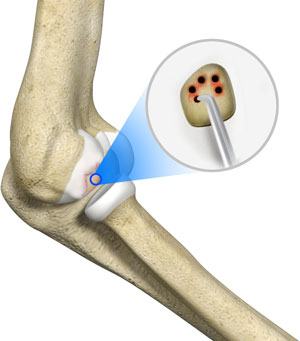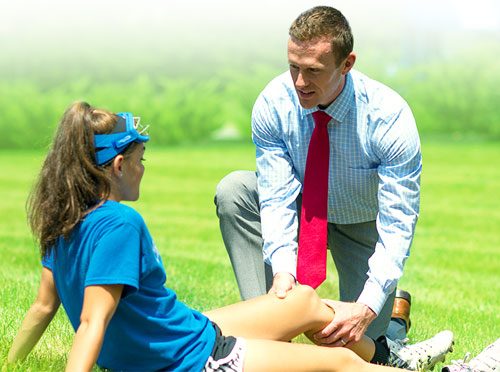Dr. Rice has joined Beacon Orthopedics and Sports Medicine
Congratulations Dr. Rice: 2025 Cincinnati Magazine Top Doctor
Capitellar OCD microfracture or OAT procedure

OATS stands for “osteochondral autograft transfer system”. It is one of two types of cartilage transfer procedures, the other is called “Mosaicplasty”. Cartilage transfer procedures involve moving healthy cartilage from an area of the knee that is non-weight bearing to a damaged cartilage area of the knee. In mosaicplasty, plugs of healthy cartilage and bone are taken from a healthy cartilage area and moved to replace the damaged cartilage area of the knee. Multiple tiny plugs are used and once embedded, resembles a mosaic, hence the name. With the OATS procedure, the plugs are larger. Therefore, the surgeon only needs to move one or two plugs of healthy cartilage and bone to the damaged area of the knee.
Indications
OATS is not recommended in everyone. OATS is typically used for younger patients (under 50) with minimal cartilage damage, usually as a result of trauma, and available healthy cartilage for transfer.
Surgical Procedure
In the OATS procedure, the surgery usually begins with an arthroscopic examination. Arthroscopy is performed in a hospital operating room under general anesthetic. Your surgeon makes a tiny incision over the knee and inserts an arthroscope. The arthroscope is a small fiber-optic viewing instrument made up of a tiny lens, light source and video camera to enable the surgeon to visually examine the knee.
If the surgeon decides the procedure can be performed, the scope is removed and an incision is made over the knee. The surgeon prepares the damaged area of cartilage. Using a special coring tool, the surgeon makes a round hole in the cartilage sized to fit the plug exactly. Your surgeon then harvests (removes) the plug of healthy cartilage and bone from the non-weight bearing part of the knee. This plug is transferred to the cored hole and implanted into the prepared hole of the damaged area of the knee. In time, a successful OATS surgery will enable the bone and cartilage to grow into the damaged area of the knee successfully resolving the patient’s knee pain.
Post-operative recovery
- You will wake up in the recovery room and then be transferred back to the ward.
- A bandage will be around the operated knee. You will usually be able to remove this the next day but leave the steri-strips in place. These will fall off on their own.
- Once you are recovered your IV will be removed and you will be shown a number of exercises to do.
- Your surgeon will see you prior to discharge and explain the findings of the operation and what was done during surgery.
- Pain medication will be provided and should be taken as directed
- It is NORMAL for the knee to swell after the surgery. You will be sent home with a cryocuff cold therapy unit. Elevating the leg when you are seated and placing Ice-Packs or the cryocuff on the knee will help to reduce swelling. (20 min 3-4 times a day until swelling has reduced)
- You will be sent home with a CPM machine (continuous passive motion) and given instructions on proper usage.
- You may shower once the bandage is removed. Leave the steristips intact.
- Please make an appointment 10-14 days after surgery to monitor your progress and remove your sutures.
- It is important to be compliant with your rehabilitation exercises to ensure a good outcome.
Risks and Complications
General anesthetic risks are extremely rare. Occasionally patients have some discomfort in the throat as a result of the tube that supplies oxygen and other gasses. Please discuss with the Anesthetist if you have any specific concerns.
Risks specifically related to the OATS surgery:
- Post-operative bleeding
- Deep Vein Thrombosis (DVT)
- Infection
- Stiffness
- Numbness to part of the skin near the incisions
- Injury to vessels, nerves and a chronic pain syndrome


